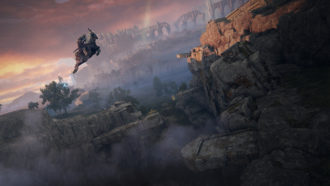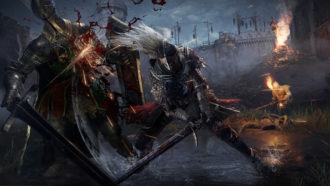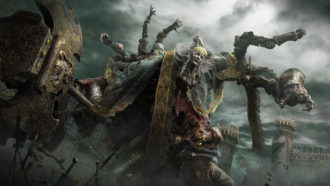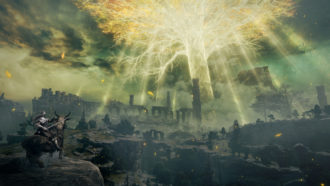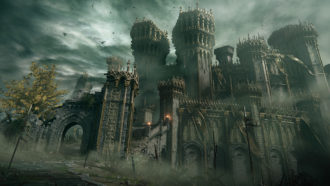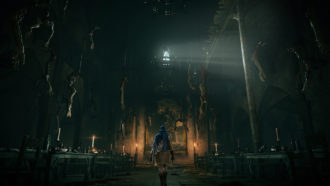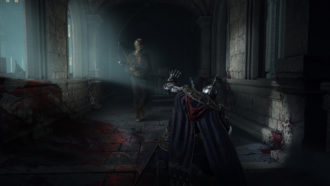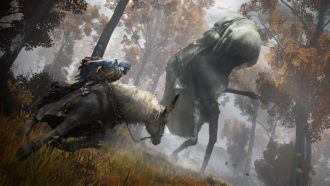A collaboration between A Song of Ice and Fire (later adapted for TV as Game of Thrones) author George R.R. Martin and revered Japanese game development studio From Software, Elden Ring is undeniably one of gaming’s most talked about upcoming releases. The Dark Souls craze never feels as though it’s slowing down and Elden Ring may well be From Software’s most ambitious Soulslike yet. With new ideas moving the game into a more open-world format, we were incredibly excited to go hands-on with the title to bring you our early impressions.
Launching in February of 2022 after a short delay, Elden Ring is a hugely anticipated release… and for good reason. There’s no debate over the impact From Software has had in the hardcore action RPG space. And this means there’s a huge possibility that comes with this studio developing a new IP in their known style for a new generation of console hardware. Not to mention the writing chops of George R.R. Martin who has created the lore for this ambitious new world. After spending dozens of hours in an early playable version of the game, I’m excited to bring my thoughts on this exciting Soulslike epic.
Elden Ring may be created with assistance from a well-known author, although that doesn’t mean the game’s narrative won’t have a distinctive Souls flair. It’s worth noting that the version of the game made available for us to play didn’t seem to incorporate an opening cinematic and likely other tidbits of narrative. However, from what I was able to experience and gather, the game treads a familiar dark fantasy path full of cryptic storytelling and the battle for one Tarnished to take down the lords of the realm and to rise up against all odds.
The game is played in the “Lands Between”. It’s a much more open space than many Souls fans would be accustomed to that allows the player more freedom in the way they approach battle or explore the world. The standard tough-as-nails action combat is present and the game will have more classes and customisation than previous From Software games. Different weaponry, armour, spells and more are found throughout the world you’re exploring and you can level up and grow more proficient in certain stats. Powerful items allow you to imbue your attacks or summon allies to fight alongside you. Stealth and horseback combat also make for incredibly viable options. Elden Ring really does feel like a world you can tackle in your own style and having that variety available from the jump is satisfying if a little overwhelming. Soon after release, we’ll no doubt see guides that outline the best builds and gear in the game, and players may likely need that advice to get through the incredibly challenging boss fights. Although until then, the game really does feel like a playground of possibility that begs for experimentation and demands you try, die, improve, and finally conquer in the face of great adversity.

It’s important to note that the pre-release game I was able to experience is still a build of the game that’s in development, with any and all of what I experienced subject to change or evolve before release. Known Soulslike elements are found here including messages left from other players and bloodstains that allow you to see another player’s death. You can summon other players to assist you but invaders may also come to try and slay you. You collect a currency as you kill things which is used in both shops and to level up, with that currency dropped upon death and then completely lost if you’re unable to pick it up before your next death. Spirit Wells allow you to rest and replenish your health and mana flasks, whilst also respawning most enemies slain. To a Dark Souls/Bloodborne/Sekiro fan, the core gameplay ideas will feel familiar.
Where Elden Ring differs is in the aforementioned open-world format, which I was able to experience in a limited way. In the opening moments of the preview, I was able to either follow the path forward, guided by the Spirit Wells, that eventually led me to a boss known as Margit the Fell Omen who promptly and swiftly handed me my own ass. The other alternative, which I quickly discovered to be the smarter of the two options, was to go off in different directions and just find out what the world has in store. The exploration for me was limited with huge fog walls stopping me from heading to certain areas, something I don’t assume will be part of the full game. What I was able to discover were mini-dungeons and caves, each with their own boss fight, that allowed me to hone my skills and gather the resources I needed for the bigger fight ahead. These dungeons give the more traditional Soulslike linearity and help the game balance those two dualities between open and structured.
Elden Ring’s open-world provides differences that Souls players may not find familiar. Being able to summon and ride your Spectral Steed was joyous but also mandatory for covering that open ground without tedium. Horseback combat was also super effective as you slash a foe and dash past before they can respond. There’s also the perfectly valid tactic of avoidance as you can just choose not to engage with an enemy and instead gallop past or around them. This does make the open-world aspects of Elden Ring easier than a Souls fan might expect, but it’s once you hit those boss fights and dungeons where the real challenge picks back up.
Pushing in the left thumbstick allows you to crouch and move stealthily through the world, using tall grass and other environmental details to help you remain undetected. I did find myself sometimes accidentally crouching during battles and other inopportune times just because it’s so easy to push in that thumbstick during moments of intensity. It’s not the perfect button to bind to an action such as crouching, but hopefully through prolonged play it’ll start to feel more natural. You can also gather resources used for crafting whilst you play, an interesting addition that works decently well for a game like this. All in all, there are plenty of incentives to go off and explore and gather in strength before you return to take down that boss who was too difficult to beat previously.
“…the ability to test your mettle against an unrelenting and unforgiving difficulty is unmatched by other developers.”
At this point, it has to be said that everything I write here comes from a big From Software fan. No matter what criticisms I may have for Elden Ring’s current state, it won’t change the fact that the game will become my next obsession once February 25th rolls around. This studio knows how to make an action RPG that feels punishing yet rewarding. They create fantastic and imaginative worlds that just feel good to inhabit, and the ability to test your mettle against an unrelenting and unforgiving difficulty is unmatched by other developers. That formula is still very much intact in Elden Ring with even more creative freedoms taken to ensure the game stands on its own as a new franchise in From’s repertoire.
With that said, Elden Ring feels a lot like a Dark Souls game. And by that I mean it literally appears to have shared animations, atmosphere, sound effects, voice cast, and mechanics taken straight from the original 2011 release and following sequels. There’s absolutely no fooling a diehard Souls fan here. The first time you creep up on an enemy from behind, lunge your sword into its back, and watch as the foe rigidly snaps into place before you kick him off your blade and onto the ground with a telltale grunt – it’s just all so familiar. On the one hand, it makes sense for the team to stay so true to the formula they’ve been praised for so much in the past. But on the other hand, when you can literally see the results of the game code that’s persisted for over a decade now, it feels like there was an opportunity to clean things up that wasn’t taken.
The above example and so many more shine a light on Elden Ring’s rougher edges. It’s where the hope of what Dark Souls could look and feel like for a new generation are dashed. Elden Ring may be a very good game, but it does feel a little dated in some ways. It makes sense too. Unlike last year’s Demon’s Souls Remake, Elden Ring is being made for both past and current console generations. I’m all for allowing as many people to experience a game as possible, but I can’t help but feel as though the game is held back by those requirements. Demon’s Souls looked so good, and it had the gameplay feel to match. It felt like a polished and refined version of a Souls game, a glimpse into what the future could hold for these titles. Elden Ring may have plenty of new ideas, but it lacks that next-gen feel of Demon’s Souls. Hopefully more of that shine and polish can be added in the next few months prior to release.
With George R.R. Martin on the ticket, you may also think that Elden Souls brings in a new mainstream audience and moves further out of its super challenging niche. This is true in some ways, but ultimately the game is not as accessible as some may like. The harsh reality of Elden Ring is that the content is still gated by ridiculously hard boss fights that simply won’t be forgiving to a more casual, less able, or less persistent audience. It’s an unforgiving game made by an unforgiving developer and I’m not yet ready to pass judgement on whether or not that’s a good or a bad thing. Perhaps it’s neither. But it’s still worth knowing for those looking at Elden Ring with concern. It is indeed an absolutely torturously challenging experience.
Overall I really did enjoy experiencing what Elden Ring had to offer in this early glimpse, even if it leans too heavily into its Dark Souls roots. I want to see more and I know I’ll be glued to that controller when I’m able to finally get my hands on the full game proper. Will it be one of Souls games I’m able to complete? Or will it eventually sit in my pile of shame alongside 2019’s Sekiro? I guess time and many deaths will tell.
